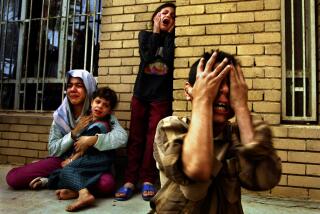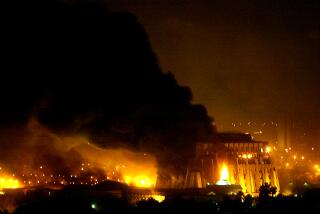Picture Hussein Gone
- Share via
Some inadvertently revealing aspects of Americans’ collective personality are the diverse images that adorn their homes, halls, dressers, walls, offices and wallets. American refrigerators are reserved for priceless crayoned images, plus youth sports schedules and the photographic likenesses of resident children, even years after that missing tooth comes in. Walls of youngsters’ rooms are often dominated by pictures of pop and sports stars and maybe airplanes, space panoramas or red autos. Family photos probably dominate elsewhere. Not every photo is studied every day, but it’s comforting in a changing culture to have such familiarity handy.
So it’s hard for many to imagine life in a land like Iraq that doesn’t democratically dispose of its political leadership every few years, to imagine residing within an enduring cult of political personality where universal allegiance is demanded and proclaimed by hanging the Revered One’s portrait in almost every office and room. Outside of the post office, the thought of even the most popular politician’s beneficent face beaming down on every activity is a tad creepy for many Americans.
So it was with considerable interest that we read John Daniszewski’s recent revealing Times account of grandiose Iraqi images, not surprisingly dominated by the bushy-mustachioed visage of Saddam Hussein. Not that anything’s wrong with large mustaches. But Hussein’s everywhere -- for now. To be sure, Americans in grade schools daily confront that ubiquitous, two-thirds-finished painting of George Washington. That George W. wears a wig. Hussein has a favorite black suit and some authoritarian hats. (Is that beret why the French like him so much?) Hussein is sometimes armed but always larger than life in his portraits. Officially, he doesn’t smile a lot. And though in his 60s, Hussein displays not even the teensiest, weensiest gray hair. But, not by accident, he is everywhere -- on clock faces, building walls, desks, in office foyers -- seeing all, hearing all. Get the picture?
One explanation is that Hussein has been around a long time -- longer than Russia’s Josef Stalin was, for instance, or North Korea’s Kim Jong Il has been. The Iraqi leader even outlasted Chicago’s Mayor Daley I. Seizing power in 1979, a year after George W. Bush suffered his only election loss, Hussein has outlasted opponents and numerous other dictators. That’s the advantage to lots of photos, rigged elections, nonexistent term limits and no living opposition in-country.
Hussein’s abundantly enthusiastic political apparatus has had nearly a quarter of a century to insinuate his image onto and into almost every corner. To many Iraqis, Hussein is synonymous with Iraq. A serious threat has arrived that may now prompt the sudden sincere removal of many, many portraits in that land. For Iraq’s long-bored portrait painters, this will mark the beginning of new creative opportunities.
More to Read
Sign up for Essential California
The most important California stories and recommendations in your inbox every morning.
You may occasionally receive promotional content from the Los Angeles Times.













